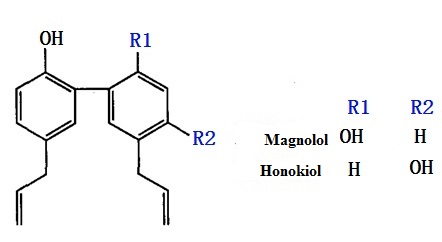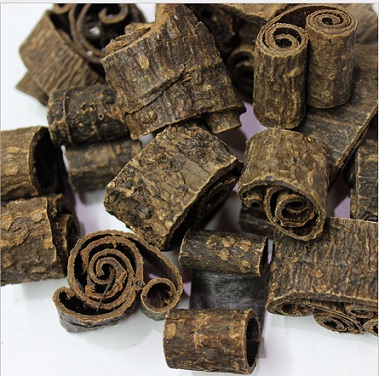| Identification | More | [Name]
Honokiol | [CAS]
35354-74-6 | [Synonyms]
3,3'-DIALLYL-4,6'-DIHYDROXYBIPHENYL
5,3'-DIALLYL-2,4'-DIHYDROXYBIPHENYL
5,3'-DIALLYL-2,4'-DIHYDROXYDIPHENYL
5,3'-DIALLYL-BIPHENYL-2,4'-DIOL
HONOKIOL
1’-Biphenyl]-2,4’-diol,3’,5-di-2-propenyl-[1
HONOKIOL 98.0% BY HPLC
HonokiolStandard
1'-Biphenyl]-2,4'-diol, 3',5-di-2-propenyl-[1-honokiol
HONEYSUCKLEFLOWEREXTRACT
[1,1'-Biphenyl]-2,4'-diol,3', 5-di-2-propenyl-
Honokiol,(S)
3',5-Diallyl-2,4'-biphenyldiol
3',5-Diallyl[1,1'-biphenyl]-2,4'-diol | [EINECS(EC#)]
609-119-8 | [Molecular Formula]
C18H18O2 | [MDL Number]
MFCD00016674 | [Molecular Weight]
266.33 | [MOL File]
35354-74-6.mol |
| Chemical Properties | Back Directory | [Melting point ]
86℃ | [Boiling point ]
400.1±40.0 °C(Predicted) | [density ]
1.107±0.06 g/cm3(Predicted) | [storage temp. ]
2-8°C
| [solubility ]
DMSO: 36 mg/mL
| [form ]
powder
| [pka]
9.89±0.48(Predicted) | [color ]
White to Off-White | [Merck ]
14,4742 | [Stability:]
Light Sensitive | [InChIKey]
FVYXIJYOAGAUQK-UHFFFAOYSA-N | [LogP]
4.200 (est) | [CAS DataBase Reference]
35354-74-6(CAS DataBase Reference) |
| Safety Data | Back Directory | [Hazard Codes ]
Xi,N | [Risk Statements ]
R41:Risk of serious damage to eyes.
R51/53:Toxic to aquatic organisms, may cause long-term adverse effects in the aquatic environment . | [Safety Statements ]
S26:In case of contact with eyes, rinse immediately with plenty of water and seek medical advice .
S39:Wear eye/face protection .
S61:Avoid release to the environment. Refer to special instructions safety data sheet . | [RIDADR ]
UN 3077 9/PG 3
| [WGK Germany ]
3
| [HazardClass ]
9 | [HS Code ]
29072990 |
| Questions And Answer | Back Directory | [Basic Information]
Honokiol is the isomer of magnolol, being the dimer polymerized by the side chain of phenylpropane and another phenylpropyl benzene nucleus, called the neolignan. It was mainly found in the Lauraceae plants, being the active ingredients of antibacterial, anti-inflammatory of the traditional Chinese medicine Magnolia.
Honokiol and magnolol appear as colorless needle crystal, being insoluble in water, soluble in chloroform, benzene, ethanol and caustic alkali. The physical and chemical constants were honokiol, mp: 102 ° C, UV λmaxEtOHnm (ε): 294 (8200); and honokiol, mp: 87.5 ° C, UV λmaxEtOHnm (ε): 294 nm (8200).

Figure 1 shows the chemical formula of magnolol and honokiol.
Magnolia is a commonly used Chinese medicine. First contained in the "Shen Nong's Herbal Classic", as the goods.
Magnolia officinalis extract is a product derived from dried root bark, bark or shoots of Magnolia officinalis, etc. The product extracts usually standardize the contents of magnolol and honokiol.
| [Distribution]
There were about 90 species of Magnoliaceae Magnolia plants around the world. There are about 30 species, of which there are about 20 kinds of medicinal value. Magnolia was born at fertile-soil, soil-deep sunny hillside, forest edge of an altitude of 300~1700 m.
Magnolia is mainly distributed in western Hubei, southern Sichuan, southern Shaanxi and southern Gansu. Magnolia is mainly distributed in Jiangxi, Anhui, Zhejiang, Fujian, Hunan, Guangxi and northern Guangdong. Magnolia officinalis has a large area of artificial cultivation.
| [Main Ingredients]
Magnolia bark contains magnolol, and honokiol, isomagnolol and other ingredients. It has been isolated of the trihydroxy honokiol, degausated trihydroxy glibenol, trihydroxy thick aldehydes, poly honokiol a, c. from the ethyl acetate extract of magnolia. Bark contains about 1% volatile oil, which mainly contains β-oleyl alcohol; still contain α-pinene, β-pinene and limonene. The bark also contains lignin. Its leaves also contain magnolol and honokiol.
[Harvest and Processing] On April to June, pick off the dried bark growing for more than 15 years, and put into the boiling water for micro-cook, and put into the soil pits, covered with grass to "sweat". When the water comes from the internal seepage and the inner surface becomes purple brown or tan, further steamed soft, remove out, roll into tube-like, and dry it Root bark and branch, after being peel down, can be directly dried.

Figure 2 is Magnolia.
| [Extraction method]
1. Magnolia extract (flow extract) production process
Take magnolia and crush it, infiltrate with ethanol for 12 hours, and place it into the percolation tube; apply 12 times the amount of ethanol for percolation; collect the percolation fluid; decompress and completely recycle the ethanol to obtain the flow extract with a yield of about 9% and the content of solid content being 85.0%. The product contains more than 11.0% of magnolol and over 5.0% honokiol.
2. Magnolol, and Honokiol extraction and separation
Take the thick and dry powder of magnolia officinalis, add 1/5 amount (W / W) of lime powder, mix well; apply 15-20 times the amount of distilled water for percolation; the percolation fluid plus hydrochloric acid was adjusted to the pH value of 2 to 3, Stand still. The precipitate was collected and washed with distilled water until the pH of the precipitate was 6 to 7. After drying, alumina (1: 10) was added and homogenized, and the extractant was extracted with cyclohexane. The cyclohexane was concentrated and allowed to cool to precipitate out the white crystals; filter to give crystals and mother liquor. Crystal is recrystallized from cyclohexane, i.e., honokiol. The mother liquor is concentrated to crystallize, further re-crystallized by cyclohexane to give colorless flaky crystals, which are magnolol crystals. The yield of honokiol was 85%, and the yield of honokiol was 74%.
| [Pharmacological effects]
1. The role of anti-pathogenic microorganisms
Magnolia has inhibitory effect against Staphylococcus aureus, Streptococcus cholerae, Escherichia coli, Proteus, Bacillus subtilis, Staphylococcus aureus, Escherichia coli, Proteus Bacilli subtilis, diphtheria bacillus and other Gram-negative bacteria, of which it has the strongest inhibitory effect on Staphylococcus aureus. At the concentration of 15%, it has inhibitory effect against the skin fungi of experimental animals including small spore ringworm, genital trichophyton and Trichophyton rubrum. Magnolia decoctum has some effect on the improvement of parenchymal pathological damage in mice with experimental viral hepatitis. Magnolol had significant antibacterial activity against Gram-positive bacteria and acid-resistant bacteria. Magnolol had significant anti-caries effect and had a minimum inhibitory concentration of 6.3 μg / ml, and its antibacterial activity was stronger than that of typical antimicrobial alkaloids Berberine (MIC: 50 μg / ml).
The saturated aqueous solution of the volatile oil of magnesium and Magnolia officinalis has certain antibacterial effect against Staphylococcus aureus, sarcina and Bacillus subtilis.
2. The role of the cardiovascular system
Magnolol and honokiol inhibit the formation of thromboxane B2 in various cases, and the increase in intracellular Ca2 + caused by arachidonic acid or collagen is also inhibited by both of them.
Honokiol can inhibit CaM to stimulate the activity of the cyclic nucleotide phosphodiesterase. Honokiol, in the presence of Ca2 +, can bind to CaM, thereby antagonizing its activation of phosphodiesterase. In addition, honokiol has a stimulating effect on the basal activity of CaM-dependent phosphodiesterase.
3. Antitumor effect
Magnolol and its hydroxymethyl derivatives have a significant inhibitory effect against the second stage of mice skin tumors. The three extraction components of Magnolia officinalis, lignans, magnolol, and honokiol and monoterpene magnolol are the antagonist of the Epstein -Barr virus early antigen activation effect induced by the 12-O-tetradecanoyl phorbol-13-acetate (TPA).
The methanol extract of Magnolia officinalis and magnolol has significant inhibitory effect on the mouse skin tumors induced by the two-stage in vivo carcinogenicity.
The toxicity of Magnolia officinalis is relatively small. Magnolia decoction: LD50 of mice subjecting to intraperitoneal injection was 6.12 ± 0.038g / kg; the LD50 for lambda alkaloids subjecting to intraperitoneal injection was 45.55mg / kg. The MLD for cat subjecting to intravenous infusion was 4.25 ± 1.25g / kg. Under the general muscle relaxation dose, the ECG of the experimental animal is not affected. Large doses can cause respiratory depression and death.
Pharmacokinetics 14C isotope tracer studies have shown that magnolol has rapid oral administration for rat; after 15 minutes, the plasma concentration reaches the peak. After oral administration of 1 hour, liver, kidney as well as stomach contains significant radioactive. The same results were obtained in 8 hours after 1 hour, and significant radioactivity was observed in the intestine.
Magnolol, after subjecting intravenous infusion, is distributed in the brain, spinal cord, liver, stomach, intestine, kidney, lung, heart, muscle and other tissues. Intravenous administration can cause significant blacking in lungs after 1 hour. This is due to that the micro-particles of the magnolol suspension are caught in the lungs. Magnolol is mainly distributed in the liver with remarkable blacking also being found in the intestine. In other tissues, the radioactivity is basically uniform distributed. In the brain, it is also seen of a similar general distribution as muscle. 8 hours later, liver, lung and kidney still contain a number of radioactivities. Remarkable blacking could be seen in the intestine, and so for stomach.
Based on the analysis of mass spectrometry, the main metabolites of Magnolol, which excreted in the fecal matter for the rats is M1, M2, M3, M4, M5, M6 and their glucuronic acid compounds and sulfates.
| [Clinical efficacy]
Magnolia can be used to treat acute enteritis, bacterial or amoebic dysentery and chronic gastritis.
| [Application overview]
Magnolia is a kind of traditional Chinese medicine, and has been included in many kinds of prescriptions. In recent years, domestic and foreign scholars, through the in-depth study of the active ingredients, pharmacodynamics and clinical pharmacy of Magnolia officinalis, have developed the Magnolia caries toothpaste, antibacterial “chewing gum” made of Magnolia extract that have been already marketed.
|
| Hazard Information | Back Directory | [Description]
Magnolol is derived from the root bark and branch bark of magnolia or Magnolia
officinalis. Magnolia officinalis was first written in the《ben jing》, it prefers cool
and humid climate and well-drained acid soil. Cortex magnoliae officinalis (hou po)
is mainly produced in Sichuan (Wan quan, Shizhu, Guanxian), Hubei (Shien,Yichang,
Lichuan), Zhejiang (Longquan, Anhui), and other places. It is also distributed in
Fujian, Jiangxi, Hunan, Guangxi, Yunnan, Guizhou, Shanxi, Gansu, and other places.
Cortex magnoliae officinalis from Sichuan and Hubei is called “chuan pu,” with better
quality, while in Zhejiang, it is called “warm park,” with a larger output. | [Physical properties]
Appearance: white fine powder. Solubility: practically insoluble in water; very soluble
in benzene, ethyl ether, chloroform, and acetone. Melting point: magnolol is
102 °C. Honokiol is 87.5 °C. | [History]
In 1930, magnolol was first isolated from the bark of Cortex magnoliae officinalis
in China by Japanese Sugii, and it was also isolated from Cortex magnoliae officinalis
in Japan. In 1973, magnolol and its isomers honokiol were isolated from Cortex magnoliae officinalis in China and Japan by Japanese Fujita.
The drug research and development of magnolol and honokiol remain in pharmacological activity and preclinical research. Kyung Hee University from Korea declared a preclinical study in 2003, in which allergy, anxiety, angina, and heart failure are indications for honokiol.
| [Uses]
Honokiol is a small-molecule polyphenol isolated from the genus Magnolia. Recent studies show that Honokiol displays antiangiogenic, antiinflammatory, and antitumor properties in preclinical models, w
ithout appreciable toxicity. Honokiol has been shown to inhibit the bone metastatic growth of human prostate cancer cells. | [Definition]
ChEBI: Honokiol is a member of biphenyls. | [Indications]
These compounds are recorded in the British Pharmacopoeia (2017) and European
Pharmacopoeia (8.7th ed.). They are mainly used as antibacterial and antifungal
agents. | [General Description]
Honokiol exhibits analgesic, antithrombotic, antispasmodic, antidepressant, antimicrobial and neuroprotective effects. It regulates gamma-aminobutyric acid (GABA) A receptors. Honokiol is associated with an increased risk of bleeding. It prevents platelet aggregation, protects myocardium from ischemic damage and inhibits ventricular arrhythmia. | [Biochem/physiol Actions]
Honokiol is a natural biphenyl neolignan from magnolia extract. It is antiangiogenic, antitumor, and anxiolytic. | [Pharmacology]
Magnolol and honokiol have the pharmacological effects of prolonging central
muscle relaxation, inhibition of the central nervous, anti-inflammatory, antibacterial,
antimicrobial, antiulcer, antioxidant, antitumor, hormone regulation, and antidiabetes
. | [storage]
Store at 2-8°C |
|
|